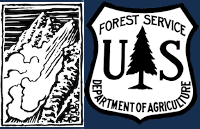From obs: "Later in the day we ran across what we assume to be a remotely triggered avalanche from another party in the area. There were two sets of tracks on the adjacent slope with cracks visible on the slope. The avalanche occurred on a 40* east aspect at 9250' and failed on the MFcr/FC dn 35cm. We looked at the crown profile, and the structure was very similar to what we found on souths. 35cm of F->4F PP/DF overlaying MFcr/FC. We did an ECT on the crown and it failed on isolation.
Northern Gallatin
Natural avalanches in the new snow, Bridger Range
1. Saw some really cool small avalanches today at Bridger. There was an obvious cycle last night on a density change, it wasn't sliding on the crust. The instability had decreased by 10 am and we couldn't get anything to move. Really cool to see such thin soft slabs propagating up to 50 ft. Good piles of debris under steep chutes.
2. Soft slabs were reactive on rocky south easterly aspects where sun crusts had formed.
In the Bridger Range, avalanches released naturally on a density change in the new snow sometime Tuesday night (3/24). Photo: E. Knoff
Forecast link: GNFAC Avalanche Forecast for Thu Mar 26, 2020
In the Bridger Range, avalanches released naturally on a density change in the new snow sometime Tuesday night (3/24). Photo: E. Knoff
Forecast link: GNFAC Avalanche Forecast for Thu Mar 26, 2020
Human Triggered Soft Slab Avalanches - Mt Blackmore
Snowfall throughout the afternoon fluctuated between S1 - S5 (during brief squalls). The winds started out moderate and from the west but calmed by the last lap ~5 pm. The new snow (from last night/this morning) was fairly well bonded to the sun/melt-freeze crust below, but the storm came in subtly upside down. Today’s snowfall (accumulating ~3” while skiing between 1-530) was light. Right along the ridgeline, we triggered 4 predictable small storm slabs 4~6” deep on the upside-down storm snow from last night/this morning, but surprisingly not on the old crust. They were each 5-10m wide x 5m long and only ran ~5m vertically.
Snowfall throughout the afternoon fluctuated between S1 - S5 (during brief squalls). The winds started out moderate and from the west but calmed by the last lap ~5 pm. The new snow (from last night/this morning) was fairly well bonded to the sun/melt-freeze crust below, but the storm came in subtly upside down. Today’s snowfall (accumulating ~3” while skiing between 1-530) was light. Right along the ridgeline, we triggered 4 predictable small storm slabs 4~6” deep on the upside-down storm snow from last night/this morning, but surprisingly not on the old crust.
Forecast link: GNFAC Avalanche Forecast for Thu Mar 26, 2020
This is a photo of a small roof avalanche near Island Park. Warming temperatures cause water to percolate through the snow which lubricates the sliding surface. Roof avalanches have injured and killed people in the past, just one more thing to worry about. Photo: M.E.
Forecast link: GNFAC Avalanche Forecast for Wed Mar 25, 2020
Dave Zinn digs a hand pit along the ridge to assess how the new snow is sticking to the ice crust. Photo: GNFAC
Forecast link: GNFAC Avalanche Forecast for Wed Mar 25, 2020
Obs: "School bus size cornices over Easterly portions of Lionhead Ridge. It is hard to tell from the photo, but the largest cornices were about 20-25' tall. We dug a few pits on East Facing slopes between 9,000-9,500 ft with the worst result being an ECTN-21 however these Cornices are primed and ready to fall with the abundant sunshine and warming weather." Photo: JR
Forecast link: GNFAC Avalanche Forecast for Tue Mar 24, 2020
